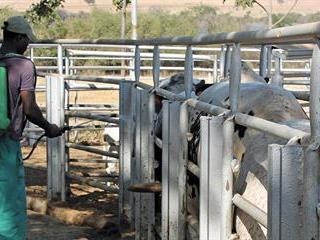
Acaricides are chemicals used to kill ticks attached to cattle. When cattle are dipped in an acaricide, the ticks clinging to them are killed or detach, and the cattle should emerge from the dip tank free of these external parasites. However, it is possible that ticks will develop a resistance to the specific chemical, especially if it has been used over a long period.
The Insecticide Resistance Action Committee (IRAC) describes pesticide resistance as “a heritable change in the sensitivity of a pest population that is reflected in the repeated failure of a product to achieve the expected level of control when used according to the label recommendation for that pest species”.
In other words, pests such as ticks acquire resistance through natural selection. The most resistant pests survive and reproduce, passing this genetic trait on to their offspring. Thus, pesticide resistance is increasing around the world. Resistance to insecticides was first documented by AL Melander in 1914 when scale insects demonstrated resistance to an inorganic insecticide.
Between 1914 and 1946, a total of 11 additional cases were recorded. Farmers in the US lost 7% of their crops to pests in the 1940s; during the 1980s and 1990s, they lost 13%, even though more pesticides were being used. In the UK today, rats in certain areas can now consume up to five times more rat poison than before without dying.
According to one source, more than 500 pest species have evolved resistance to a pesticide. Other researchers say the number is much higher.
What to do
The department of agriculture and the ARC suggest the following procedures in dipping livestock using acaricides:
- If you find many ticks active on your cattle after dipping, confirm that you do indeed have a resistance problem;
- Check that you have followed the directions for the dip properly. Ticks might remain on livestock because the dip has not been used at the correct strength. If you use a plunge dip, mix the right quantity of dip for the size of the dip tank.
- Ask your animal health technician to assist you in measuring the dip strength to ensure that this is not the problem;
- If you are using the dip correctly, and the dip strength is as it should be, the problem may be acaricide resistance. In this case, the animal health technician will help you collect some ticks remaining on your cattle after dipping. The sample will then be sent to a laboratory to test for resistance. The laboratory will confirm if acaricide resistance is a problem in your area and, if so, advise you which types of acaricides to use.
Prevention
To avoid ticks becoming resistant to acaricides:
- Get advice from your animal health technician or vet about which acaricides are best to use in your area and how to use them to avoid resistance developing;
- Dip strategically, not routinely;
- Use the correct dilution;
- Never use homemade dips.
Sources: Directorate Communication Services, DAFF, in cooperation with ARC-Onderstepoort Veterinary Institute.
Visit irac-online.org, or grapes.msu.edu.












